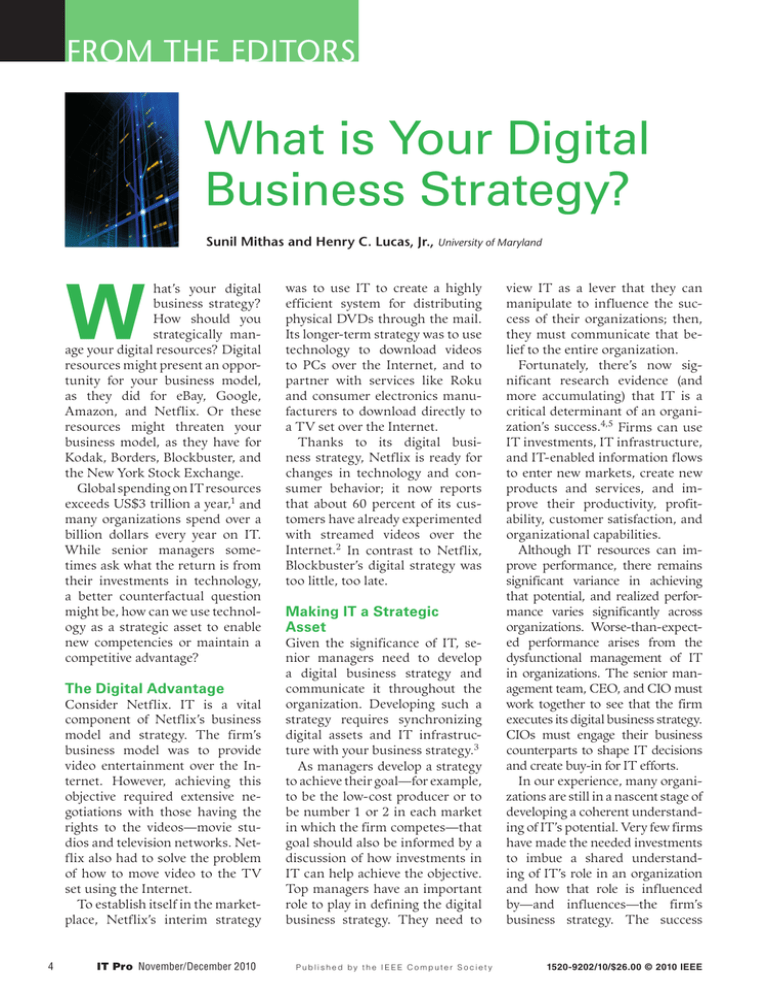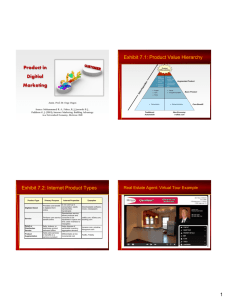W What is Your Digital Business Strategy? From the editors
advertisement

From the editors What is Your Digital Business Strategy? Sunil Mithas and Henry C. Lucas, Jr., University of Maryland W hat’s your digital business strategy? How should you strategically manage your digital resources? Digital resources might present an opportunity for your business model, as they did for eBay, Google, Amazon, and Netflix. Or these resources might threaten your business model, as they have for Kodak, Borders, Blockbuster, and the New York Stock Exchange. Global spending on IT resources exceeds US$3 trillion a year,1 and many organizations spend over a billion dollars every year on IT. While senior managers sometimes ask what the return is from their investments in technology, a better counterfactual question might be, how can we use technology as a strategic asset to enable new competencies or maintain a competitive advantage? The Digital Advantage Consider Netflix. IT is a vital component of Netflix’s business model and strategy. The firm’s business model was to provide video entertainment over the Internet. However, achieving this objective required extensive negotiations with those having the rights to the videos—movie studios and television networks. Netflix also had to solve the problem of how to move video to the TV set using the Internet. To establish itself in the marketplace, Netflix’s interim strategy 4 IT Pro November/December 2010 was to use IT to create a highly efficient system for distributing physical DVDs through the mail. Its longer-term strategy was to use technology to download videos to PCs over the Internet, and to partner with services like Roku and consumer electronics manufacturers to download directly to a TV set over the Internet. Thanks to its digital business strategy, Netflix is ready for changes in technology and consumer behavior; it now reports that about 60 percent of its customers have already experimented with streamed videos over the Internet.2 In contrast to Netflix, Blockbuster’s digital strategy was too little, too late. Making IT a Strategic Asset Given the significance of IT, senior managers need to develop a digital business strategy and communicate it throughout the organization. Developing such a strategy requires synchronizing digital assets and IT infrastructure with your business strategy.3 As managers develop a strategy to achieve their goal—for example, to be the low-cost producer or to be number 1 or 2 in each market in which the firm competes—that goal should also be informed by a discussion of how investments in IT can help achieve the objective. Top managers have an important role to play in defining the digital business strategy. They need to Published by the IEEE Computer Society view IT as a lever that they can manipulate to influence the success of their organizations; then, they must communicate that belief to the entire organization. Fortunately, there’s now significant research evidence (and more accumulating) that IT is a critical determinant of an organization’s success.4,5 Firms can use IT investments, IT infrastructure, and IT-enabled information flows to enter new markets, create new products and services, and improve their productivity, profitability, customer satisfaction, and organizational capabilities. Although IT resources can improve performance, there remains significant variance in achieving that potential, and realized performance varies significantly across organizations. Worse-than-expected performance arises from the dysfunctional management of IT in organizations. The senior management team, CEO, and CIO must work together to see that the firm executes its digital business strategy. CIOs must engage their business counterparts to shape IT decisions and create buy-in for IT efforts. In our experience, many organizations are still in a nascent stage of developing a coherent understanding of IT’s potential. Very few firms have made the needed investments to imbue a shared understanding of IT’s role in an organization and how that role is influenced by—and influences—the firm’s business strategy. The success 1520-9202/10/$26.00 © 2010 IEEE of the IT effort depends on communicating the firm’s strategy and enlisting managers at all levels in making decisions about technology. This is where many organizations flounder. However, it’s possible to overcome this hurdle by investing in digital literacy—what we call ITracy. ITracy: A New Competence for the Information Age There’s a compelling need for CEOs and CIOs to make necessary investments in ITracy for key executives and future leaders of their companies. We view ITracy as a new word and skill that should be a part of boardroom discussions about strategy or about selecting business leaders; it’s a skill, similar to literacy or numeracy, that all successful managers must have in today’s information economy. ITracy rests on three pillars: it implies a basic understanding of how a firm should synchronize its business strategy with its IT strategy, how the firm should govern IT, and how the firm should manage its IT infrastructure and implement IT projects. Synchronize IT and Business Synchronizing IT and business strategies requires developing an understanding of how a firm can manage IT to improve its competitive position and how it should manage or shape industry transformations. As Michael Porter, a Harvard Business School professor has argued,6 there are three principal ways to gain a competitive advantage using IT. The first is by changing the industry structure, which involves using IT to tilt the balance of supplier power, customer power, competitive rivalry, and the threat of new and substitute products in your favor. A second way is to outperform rivals using IT in terms of cost differentiation or the ability to serve a niche segment exceptionally well by providing differentiated, cost-effective products and services. A third way is to create new businesses using IT. In addition, the firm also needs to decide its strategic posture with respect to industry transformations and new technologies. It’s particularly challenging to consider new technologies that create a trade-off between serving current customers and bringing in new, underserved customers. Govern IT Effectively coherent digital business strategy. Even with perfect governance, there remains a need to manage IT projects toward successful completion. Success requires that managers develop a vision about how they will deal with the evolution of computing, manage legacy upgrade decisions, manage risks in IT projects, determine what systems development lifecycle approach to use, and select which enterprise systems to deploy. Although we discussed synchronization-governance-management decisions separately, they are interconnected. Governance cannot be viewed in isolation from strategy. Governance processes in firms that emphasize revenue growth will differ from governance processes in firms that emphasize cost reduction in their digital business strategy. In turn, governance will ultimately influence management in terms of what types of projects an organization will implement and how certain trade-offs (standardization versus customization, single vendor versus best-of-the-breed) will be made. Even if managers can synchronize their IT and business strategy, that’s not enough. There remains a need to ensure that the digital strategy is made part and parcel of an organization’s governance processes. In other words, managers also need to govern IT effectively. Governance involves five things. First, the manager must decide what the key IT decisions are and who should make them and how. The second consideration is how the IT function should be organized: as a cost or profit center. Third, the manager must determine how much to spend on IT and on what types of projects (for example, for revenue-growth or cost-reduction projects?). Fourth, the manager must also justify and prioritize different types of IT projects to arrive at a portfolio that will achieve the firm’s key strategic objectives. The final consideration is deciding what to keep in-house, what to outsource or rent, and the extent to which the firm will use globally dispersed resources. All of these governance decisions have options—only some of which might be practical given the organization’s resources and competitive environment. enior executives and IT professionals have a responsibility to ensure that all IT and strategic decisions in their firms are approached by individuals who have the requisite ITracy and who are exposed to the three pillars of a digital business strategy. Doing so will require investing in the education of key professionals followed by a continuous dialogue between business and IT personnel. Only then will digital business strategies successfully lead to business value and a competitive advantage. Manage IT with Discipline References But there’s still more needed before an organization has a 1. J. Scheck, B. Worthen, and P.-W. Tam, “Dell Forecasts Soft Demand, S computer.org/ITPro 5 From the editors New Editorial Board Members Irena Bojanova is a program director, Telecommunications Management, and an associate professor in the Graduate School of Management and Technology at the University of Maryland University College (UMUC). Her research interests include cloud computing, virtual environments, and educational innovations. Bojanova received her PhD in computer science and mathematics from the Bulgarian Academy of Sciences. She costarted OBS Ltd. (now CSC Bulgaria), currently employing over 500 software developers, and cofounded PIsoft Ltd., a successful educational company in Sofia, Bulgaria. She is a member of IEEE, the National Professional Science Master’s Association, and Sloan-C. Contact her at ibojanova@umuc.edu. Gustavo Rosi is a full professor of computer science at La Plata University, Argentina. His research interests include modeling and design issues for advanced Web applications—particularly those that involve context-aware behaviors. Rosi received his PhD from the Pontifícia Universidade Católica do Rio de Janeiro, Brazil, focusing on the development of the objectoriented hypermedia design method. He’s a member of the editorial board of WWW Journal, the Journal of Web Engineering, the Journal of Internet Services and Applications, and IEEE Internet Computing. He served as program chair of 10th International Conference on Web Engineering. Contact him at gustavo@lifia.info.unlp.edu.ar. COMPUTING THEN Learn about computing history and the people who shaped it. http://computingnow. computer.org/ct but Rivals Are Upbeat,” Wall Street J., WSJ Marketplace, 17 Sept. 2008, p. B1. 2. R. Grover, “Netflix: Premium Cable’s Worst Nightmare,” Bloomberg Business Week, 16 Sept. 2010, pp. 21–22; www. businessweek.com/magazine/content/ 10_39/b4196021822248.htm. 3. C.K. Prahalad and M.S. Krishnan, “The Dynamic Synchronization of Strategy and Information Technology,” MIT Sloan Management Rev., Summer 2002, pp. 24–33. 4. R. Kohli and V. Grover, “Business Value of IT: An Essay on Expanding Research Directions to Keep Up with the Times,” J. Assoc. Information Systems, vol. 9, no. 1, 2008, pp. 23–39. 5. S. Mithas, N. Ramasubbu, and V. Sambamurthy, “How Information Management Capability Influences Firm Performance,” to be published in MIS Quarterly, vol. 35, no. 1, 2011. 6. M.E. Porter and V.E. Millar, “How Information Gives You Competitive Advantage,” Harvard Business Rev., vol. 63, no. 4, 1985, pp. 149–160. Sunil Mithas is an associate professor in the Robert H. Smith School of Business at the University of Maryland and a member of IT Professional’s editorial board. His research focuses on the strategic management and impact of information technology resources. Mithas has a PhD in business from the Ross School of Business at the University of Michigan. Contact him at smithas@rhsmith.umd.edu. Henry C. Lucas, Jr. is the Robert H. Smith Professor of Information in the Robert H. Smith School of Business, at the University of Maryland. His research interests include IT-enabled transformations, the impact of IT on organizations, IT in organization design, electronic commerce, and the value of IT. Lucas received his PhD from the Sloan School of Management, MIT. Contact him at hlucas@rhsmith.umd.edu. Selected CS articles and columns are available for free at http://ComputingNow.computer.org. 6 IT Pro November/December 2010


